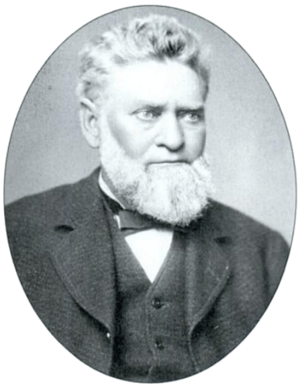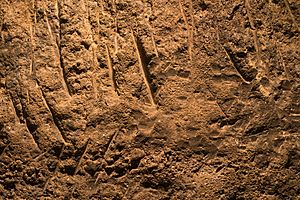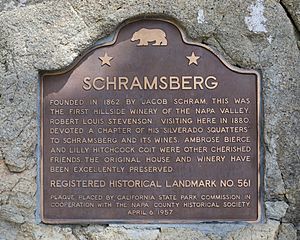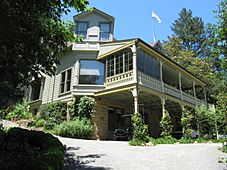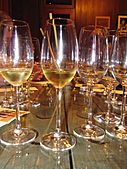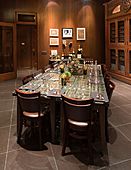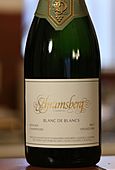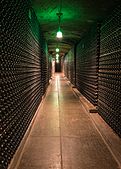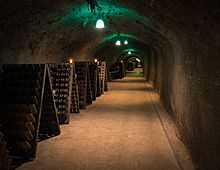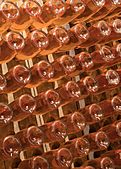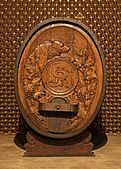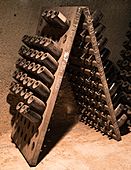Schramsberg Vineyards facts for kids
Quick facts for kids Schramsberg Vineyards |
|
|---|---|
 |
|
| Location | Calistoga, California, USA |
| Appellation | Napa Valley |
| Other labels | J. Davies |
| Founded | 1862 by Jacob Schram 1965 reopened by Jack and Jamie Davies |
| Key people | Hugh Davies (CEO) |
| Known for | California Sparkling Wine |
| Distribution | International |
| Tasting | Open to the public |
| Website | www.schramsberg.com |
| Designated: | 1998 |
| Reference #: | 98001251 |
| Designated: | 1956 |
| Reference #: | 561 |
Schramsberg Vineyards is a famous winery located in Calistoga, California, in the beautiful Napa Valley area. It was started way back in 1862 by a German immigrant named Jacob Schram. This winery is special because it makes sparkling wines, which are bubbly wines, using the same traditional method as the famous Champagne from France. Many people think Schramsberg makes some of the best sparkling wines in California. It was even the first U.S. winery to create a sparkling wine that was as good as the best French Champagnes.
After being closed for almost 50 years, Schramsberg was bought by Jack and Jamie Davies in 1965. They decided to bring the winery back to life and focus on making sparkling wine using the Champagne method. Today, their youngest son, Hugh Davies, is in charge of Schramsberg.
Contents
The Story of Schramsberg Vineyards
Starting the Winery (1862–1905)
In 1862, Jacob Schram bought the land that would become Schramsberg. He wanted to grow grapes and make wine in the hills of Napa Valley. Even though Jacob came from a family of winemakers, he worked as a barber. He was one of the first winemakers to arrive in Napa in the mid-1800s. Jacob was born in 1826 in a town called Pfeddersheim in Germany. He moved to the U.S. in 1852 and married Annie Weaver, who was also from Germany, in 1859.
After clearing the land, Jacob and Annie started planting different types of grapes to make wine. In the 1870s, Jacob dug special cellars into the hills on his property. By 1876, Schramsberg was making 12,000 gallons of wine! In just a few years, the vineyard grew to cover more than 50 acres. It was producing 12,000 cases of wine every year.
Schramsberg became quite famous in the 1880s. This was because it was mentioned in a book called The Silverado Squatters by Robert Louis Stevenson. Stevenson, who wrote Treasure Island, visited Napa Valley in 1880 with his new wife, Fanny Vandegrift, and her son, Lloyd Osbourne. He wrote about his adventures and the people who helped shape the region. He even wrote that he tasted eighteen different wines when he visited Schramsberg.
Stevenson wrote about his visit:
- "I was interested in California wine... A California vineyard... has features of its own... We visited two of them, Mr. Schram's and Mr. McEachran's, sharing the same glen..."
Schramsberg continued to do well until the end of the 1800s. Annie Schram passed away in 1901. Jacob Schram died four years later in 1905. He left the winery to his son, Herman Schram.
A Quiet Period (1905–1965)
Herman tried to keep the business going, but after only a few years, he sold the property. Over the next 40 years, Schramsberg changed owners many times. None of these owners used the property to make wine. Instead, some used it as a summer home.
In 1951, Douglas Pringle bought Schramsberg. His wife, Katharine Cebrian, worked hard to get the winery recognized. Because of her efforts, Schramsberg was named a state historical landmark on December 31, 1956. After the Pringles divorced in 1959, the property was not used for several years.
Bringing Schramsberg Back to Life (1965-Today)
After being neglected for years, Jack and Jamie Davies bought Schramsberg in 1965. They had spent a year searching for the perfect place in Napa Valley to make wine. When they bought it, Schramsberg was run-down and had been empty for a long time.
Instead of making the usual types of wine found in Napa back then, the Davies decided to make sparkling wine. They wanted to use the same special Champagne method that was used in France.
In 1972, something very important happened. Schramsberg's 1969 "Blanc de Blancs" (which means "white of whites") sparkling wine was served at a special event called the "Toast to Peace" in Beijing, China. This toast was between U.S. President Richard Nixon and Chinese Premier Zhou Enlai. Since that time, Schramsberg's wines have been served by every U.S. president.
Schramsberg has won many awards over the years. In 1995, it received a Lifetime Achievement Award. In 1996, the James Beard Foundation gave Schramsberg the Wine and Spirits Professional Award. This award recognized their big impact on the wine and spirits industry.
In 1996, Hugh Davies, the youngest son of Jack and Jamie Davies, started working full-time at the winery. Hugh had studied winemaking at the University of California, Davis. It's interesting that Hugh was born in 1965, the same year his parents bought the Schramsberg property! The winery was also added to the National Register of Historic Places in 1998.
Jack Davies passed away in 1998, and Jamie Davies passed away in 2008. Today, Hugh Davies is the CEO of Schramsberg.
Gallery
- Schramsberg Vineyards
See also
- John Winsell Davies, son of Jack and Jamie Davies


